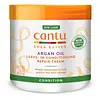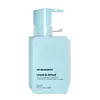What's inside
What's inside
 Key Ingredients
Key Ingredients

No key ingredients
 Benefits
Benefits

 Concerns
Concerns

 Ingredients Side-by-side
Ingredients Side-by-side

Water
Skin ConditioningCetearyl Alcohol
EmollientCanola Oil
EmollientGlycerin
HumectantPolyquaternium-37
Parfum
MaskingPropylene Glycol Dicaprylate/Dicaprate
EmollientBehentrimonium Methosulfate
Dicetyldimonium Chloride
EmulsifyingOlea Europaea Fruit Oil
MaskingButyrospermum Parkii Butter
Skin ConditioningCapryloyl Glycerin/Sebacic Acid Copolymer
Skin ConditioningDiheptyl Succinate
EmollientPhenoxyethanol
PreservativeEthylhexylglycerin
Skin ConditioningPropylene Glycol
HumectantArgania Spinosa Kernel Oil
EmollientPolyquaternium-10
Trideceth-6
EmulsifyingC11-15-Isoalkanes
PerfumingCitric Acid
BufferingDisodium EDTA
Sodium Chloride
MaskingSodium Ferrocyanide
Limonene
PerfumingBenzyl Alcohol
PerfumingLinalool
PerfumingWater, Cetearyl Alcohol, Canola Oil, Glycerin, Polyquaternium-37, Parfum, Propylene Glycol Dicaprylate/Dicaprate, Behentrimonium Methosulfate, Dicetyldimonium Chloride, Olea Europaea Fruit Oil, Butyrospermum Parkii Butter, Capryloyl Glycerin/Sebacic Acid Copolymer, Diheptyl Succinate, Phenoxyethanol, Ethylhexylglycerin, Propylene Glycol, Argania Spinosa Kernel Oil, Polyquaternium-10, Trideceth-6, C11-15-Isoalkanes, Citric Acid, Disodium EDTA, Sodium Chloride, Sodium Ferrocyanide, Limonene, Benzyl Alcohol, Linalool
Water
Skin ConditioningDimethicone
EmollientCaprylic/Capric Triglyceride
MaskingPanthenol
Skin ConditioningBromelain
Skin ConditioningPapain
Skin ConditioningHydrolyzed Pea Protein
EmollientLaurdimonium Hydroxypropyl Hydrolyzed Keratin
Skin ConditioningPelargonium Graveolens Flower Oil
MaskingCitrus Aurantium Dulcis Peel Oil
MaskingPogostemon Cablin Leaf Oil
MaskingEugenia Caryophyllus Leaf Oil
MaskingBambusa Vulgaris Leaf/Stem Extract
HumectantSimmondsia Chinensis Seed Oil
EmollientCinnamomum Cassia Leaf Oil
MaskingGlycerin
HumectantUbiquinone
AntioxidantSodium Laneth-40 Maleate/Styrene Sulfonate Copolymer
Cetyl Alcohol
EmollientIsopropyl Myristate
EmollientIsopropyl Alcohol
SolventPropylene Glycol
HumectantLaureth-7
EmulsifyingButylene/Ethylene/Styrene Copolymer
Ethylene/Propylene/Styrene Copolymer
Polyacrylamide
C13-14 Isoparaffin
EmollientBehentrimonium Chloride
PreservativePhenoxyethanol
PreservativeBHT
AntioxidantEthylhexylglycerin
Skin ConditioningChlorphenesin
AntimicrobialSorbic Acid
PreservativeBenzoic Acid
MaskingParfum
MaskingLimonene
PerfumingEugenol
PerfumingCinnamal
PerfumingGeraniol
PerfumingWater, Dimethicone, Caprylic/Capric Triglyceride, Panthenol, Bromelain, Papain, Hydrolyzed Pea Protein, Laurdimonium Hydroxypropyl Hydrolyzed Keratin, Pelargonium Graveolens Flower Oil, Citrus Aurantium Dulcis Peel Oil, Pogostemon Cablin Leaf Oil, Eugenia Caryophyllus Leaf Oil, Bambusa Vulgaris Leaf/Stem Extract, Simmondsia Chinensis Seed Oil, Cinnamomum Cassia Leaf Oil, Glycerin, Ubiquinone, Sodium Laneth-40 Maleate/Styrene Sulfonate Copolymer, Cetyl Alcohol, Isopropyl Myristate, Isopropyl Alcohol, Propylene Glycol, Laureth-7, Butylene/Ethylene/Styrene Copolymer, Ethylene/Propylene/Styrene Copolymer, Polyacrylamide, C13-14 Isoparaffin, Behentrimonium Chloride, Phenoxyethanol, BHT, Ethylhexylglycerin, Chlorphenesin, Sorbic Acid, Benzoic Acid, Parfum, Limonene, Eugenol, Cinnamal, Geraniol
Ingredients Explained
These ingredients are found in both products.
Ingredients higher up in an ingredient list are typically present in a larger amount.
Ethylhexylglycerin (we can't pronounce this either) is commonly used as a preservative and skin softener. It is derived from glyceryl.
You might see Ethylhexylglycerin often paired with other preservatives such as phenoxyethanol. Ethylhexylglycerin has been found to increase the effectiveness of these other preservatives.
Glycerin is already naturally found in your skin. It helps moisturize and protect your skin.
A study from 2016 found glycerin to be more effective as a humectant than AHAs and hyaluronic acid.
As a humectant, it helps the skin stay hydrated by pulling moisture to your skin. The low molecular weight of glycerin allows it to pull moisture into the deeper layers of your skin.
Hydrated skin improves your skin barrier; Your skin barrier helps protect against irritants and bacteria.
Glycerin has also been found to have antimicrobial and antiviral properties. Due to these properties, glycerin is often used in wound and burn treatments.
In cosmetics, glycerin is usually derived from plants such as soybean or palm. However, it can also be sourced from animals, such as tallow or animal fat.
This ingredient is organic, colorless, odorless, and non-toxic.
Glycerin is the name for this ingredient in American English. British English uses Glycerol/Glycerine.
Learn more about GlycerinLimonene is a fragrance that adds scent and taste to a formulation.
It's found in the peel oil of citrus fruits and other plants such as lavender and eucalyptus. The scent of limonene is generally described as "sweet citrus".
Limonene acts as an antioxidant, meaning it helps neutralize free radicals.
When exposed to air, oxidized limonene may sensitize the skin. Because of this, limonene is often avoided by people with sensitive skin.
The term 'fragrance' is not regulated in many countries. In many cases, it is up to the brand to define this term. For instance, many brands choose to label themselves as "fragrance-free" because they are not using synthetic fragrances. However, their products may still contain ingredients such as essential oils that are considered a fragrance.
Learn more about LimoneneParfum is a catch-all term for an ingredient or more that is used to give a scent to products.
Also called "fragrance", this ingredient can be a blend of hundreds of chemicals or plant oils. This means every product with "fragrance" or "parfum" in the ingredients list is a different mixture.
For instance, Habanolide is a proprietary trade name for a specific aroma chemical. When used as a fragrance ingredient in cosmetics, most aroma chemicals fall under the broad labeling category of “FRAGRANCE” or “PARFUM” according to EU and US regulations.
The term 'parfum' or 'fragrance' is not regulated in many countries. In many cases, it is up to the brand to define this term.
For instance, many brands choose to label themselves as "fragrance-free" because they are not using synthetic fragrances. However, their products may still contain ingredients such as essential oils that are considered a fragrance by INCI standards.
One example is Calendula flower extract. Calendula is an essential oil that still imparts a scent or 'fragrance'.
Depending on the blend, the ingredients in the mixture can cause allergies and sensitivities on the skin. Some ingredients that are known EU allergens include linalool and citronellol.
Parfum can also be used to mask or cover an unpleasant scent.
The bottom line is: not all fragrances/parfum/ingredients are created equally. If you are worried about fragrances, we recommend taking a closer look at an ingredient. And of course, we always recommend speaking with a professional.
Learn more about ParfumPhenoxyethanol is a preservative that has germicide, antimicrobial, and aromatic properties. Studies show that phenoxyethanol can prevent microbial growth. By itself, it has a scent that is similar to that of a rose.
It's often used in formulations along with Caprylyl Glycol to preserve the shelf life of products.
Propylene Glycol is an odorless, colorless liquid. As a humectant, it helps skin retain moisture. It also aids in delivering active ingredients.
Another role of this ingredient is preventing a product from melting or freezing. Propylene glycol also adds antimicrobrial properties to a product, elongating product lifespan.
This ingredient is considered an organic alcohol and commonly added into both cosmetics and foods.
Those with sensitive skin or conditions may develop a rash when using this ingredient.
Learn more about Propylene GlycolWater. It's the most common cosmetic ingredient of all. You'll usually see it at the top of ingredient lists, meaning that it makes up the largest part of the product.
So why is it so popular? Water most often acts as a solvent - this means that it helps dissolve other ingredients into the formulation.
You'll also recognize water as that liquid we all need to stay alive. If you see this, drink a glass of water. Stay hydrated!
Learn more about Water